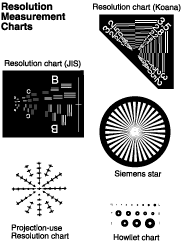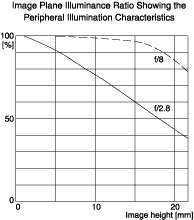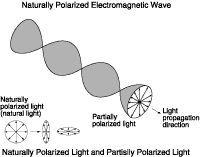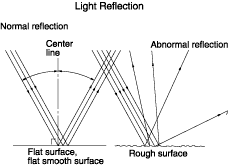 Paraxial
ray Paraxial
ray |
 |
|
A light ray which passes close to the
optical axis and is inclined at a very small angle with
respect to the optical axis. The point at which paraxial
rays converge is called the paraxial focal point. Since
the image formed by a monochromatic paraxial ray is in
principle free of aberrations, the paraxial ray is an
important factor in understanding the basic operation of
lens systems. |
 Peripheral
illumination Peripheral
illumination |
 |
|
The brightness of a lens is
determined by the F number, but this value only
indicates the brightness at the optical axis position,
i.e., at the center of the image. The brightness (image
surface illuminance) at the edge of the image is called
peripheral illumination and is expressed as a percent
(%) of the amount of illumination at the image center.
Peripheral illumination is affected by lens vignetting
and the cos4 (cosine 4) law and is inevitably lower than
the center of the image. |
 Polarized
light Polarized
light |
 |
|
Since light is a type of
electromagnetic wave, it can be thought of as uniformly
vibrating in all directions in a plane perpendicular to
the direction of propagation. This type of light is
called natural light (or natural polarized light). If
the direction of vibration of natural light becomes
polarized for some reason, that light is called
polarized light. When natural light is reflected from
the surface of glass or water, for example, the
reflected light vibrates in one direction only and is
completely polarized. Also, on a sunny day the light
from the area of the sky at a 90º angle from the sun
becomes polarized due to the effect of air molecules and
particles in the atmosphere. The half-mirrors used in
autofocus SLR cameras also cause light polarization.
|
 Principal point (Nodal
point) Principal point (Nodal
point) |
 |
|
The focal length of a thin,
double-convex, single-element lens is the distance along
the optical axis from the center of the lens to its
focal point. This center point of the lens is called the
principal point. However, since actual photographic
lenses consist of combinations of several convex and
concave lens elements, it is not visually apparent where
the center of the lens might be. The principal point of
a multi-element lens is therefore defined as the point
on the optical axis at a distance equal to the focal
length measured back toward the lens from the focal
point. The principal point measured from the front focal
point is called the front principal point, and the
principal point measured from the rear focal point is
called the rear principal point. The distance between
these two principal points is called the principal point
interval. |
 Principal ray Principal ray |
 |
|
A light ray which enters the lens at
an angle at a point other than the optical axis point
and passes through the center of the diaphragm opening.
Principal light rays are the fundamental light rays used
for image exposure at all diaphragm openings from
maximum aperture to minimum aperture. |
 Rear
focusing Rear
focusing |
 |
|
Focusing is accomplished by moving
one or more lens elements positioned internally, behind
the lens’ diaphragm assembly. By moving internal
elements, less weight is required to be moved, so
focusing can be faster and more responsive. Furthermore,
the front of the lens does not move during focusing —
ideal for photographers who use filters. |
 Reduction in overall
lens length Reduction in overall
lens length |
 |
|
To reduce the length of a telephoto
lens, it is necessary to increase the mutual power of
the convex-concave groupings. Fluorite’s low index of
refraction makes it possible to achieve significant
reduction in lens length while maintaining high image
quality.
Although the extraordinary optical
properties of fluorite were discovered in the 19th
century and lens designers have long desired to use it,
naturally formed pieces of fluorite large enough for use
in lens production are extremely difficult to find.
Deciding to solve this problem, Canon took up the
challenge of developing synthetic crystals, bringing
practical fluorite production technology on-line by the
late 1960’s. |
 Reflection Reflection |
 |
|
Reflection differs from reflection in
that it is a phenomenon which causes a portion of the
light striking the surface of glass or other medium to
break off and propagate in an entirely new direction.
The direction of propagation is the same regardless of
wavelength. When light enters and leaves a lens which
does not have an anti-reflection coating, approximately
5% of the light is reflected at the glass-air boundary.
The amount of light direction of propagation. The two
elements of a light wave which can actually be detected
by the human eye are the wavelength and amplitude.
Differences in wavelength are sensed as differences in
color (within the visible light range) and differences
in amplitude are sensed as differences in brightness
(light intensity). The third element which cannot be
detected by the human eye is the direction of vibration
within the plane perpendicular to the light wave’s
direction of propagation. |
 Resolution Resolution |
 |
 |
The resolution of a lens indicates
the capacity of reproduction of a subject point of the
lens. The resolution of the final photograph depends on
three factors: the resolution of the lens, the
resolution of the film, and the resolution of the
printing paper. Resolution is evaluated by
photographing, at a specified magnification, a chart
containing groups of black and white stripes that
gradually decrease in narrowness, then using a
microscope to observe the negative image at a
magnification of 50x. It is common to hear resolution
expressed as a numerical value such as 50 lines or 100
lines. This value indicates the number of lines per
millimeter of the smallest black and white line pattern
which can be clearly recorded on the film. To test the
resolution of a lens alone, a method is used in which a
fine resolution chart is positioned in the location
corresponding to the film plane and projected through
the test lens onto a screen. The numerical value used
for expressing resolving power is only an indication of
the degree of resolution possible, and does not indicate
resolution clarity or contrast. |
 |
  |
 |
![]()




